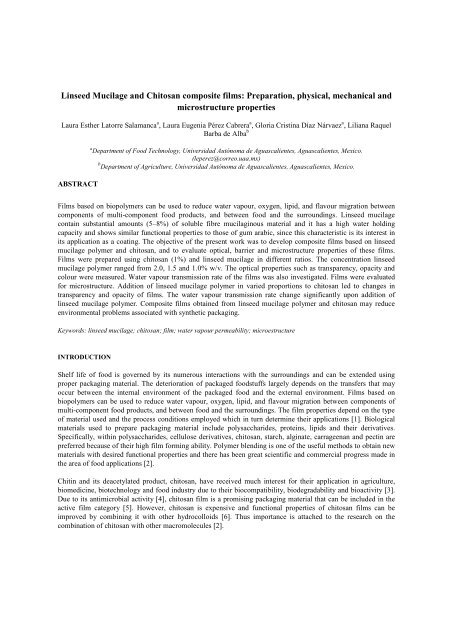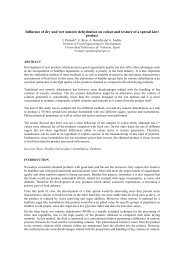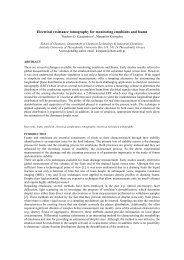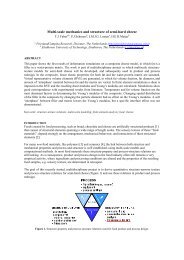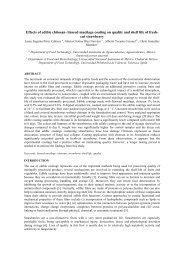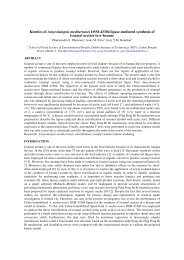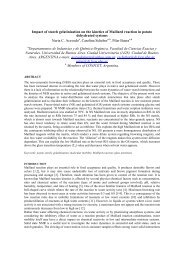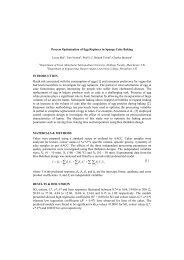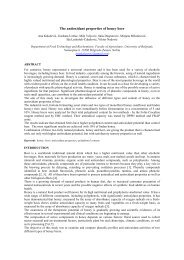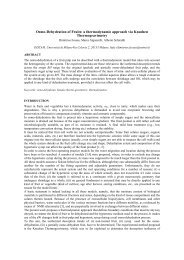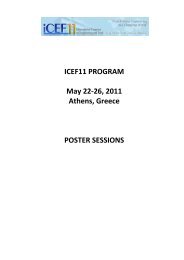Linseed Mucilage and Chitosan composite films - 11th International ...
Linseed Mucilage and Chitosan composite films - 11th International ...
Linseed Mucilage and Chitosan composite films - 11th International ...
You also want an ePaper? Increase the reach of your titles
YUMPU automatically turns print PDFs into web optimized ePapers that Google loves.
<strong>Linseed</strong> <strong>Mucilage</strong> <strong>and</strong> <strong>Chitosan</strong> <strong>composite</strong> <strong>films</strong>: Preparation, physical, mechanical <strong>and</strong><br />
microstructure properties<br />
Laura Esther Latorre Salamanca a , Laura Eugenia Pérez Cabrera a , Gloria Cristina Díaz Nárvaez a , Liliana Raquel<br />
Barba de Alba b<br />
a Department of Food Technology, Universidad Autónoma de Aguascalientes, Aguascalientes, Mexico.<br />
(leperez@correo.uaa.mx)<br />
b Department of Agriculture, Universidad Autónoma de Aguascalientes, Aguascalientes, Mexico.<br />
ABSTRACT<br />
Films based on biopolymers can be used to reduce water vapour, oxygen, lipid, <strong>and</strong> flavour migration between<br />
components of multi-component food products, <strong>and</strong> between food <strong>and</strong> the surroundings. <strong>Linseed</strong> mucilage<br />
contain substantial amounts (5–8%) of soluble fibre mucilaginous material <strong>and</strong> it has a high water holding<br />
capacity <strong>and</strong> shows similar functional properties to those of gum arabic, since this characteristic is its interest in<br />
its application as a coating. The objective of the present work was to develop <strong>composite</strong> <strong>films</strong> based on linseed<br />
mucilage polymer <strong>and</strong> chitosan, <strong>and</strong> to evaluate optical, barrier <strong>and</strong> microstructure properties of these <strong>films</strong>.<br />
Films were prepared using chitosan (1%) <strong>and</strong> linseed mucilage in different ratios. The concentration linseed<br />
mucilage polymer ranged from 2.0, 1.5 <strong>and</strong> 1.0% w/v. The optical properties such as transparency, opacity <strong>and</strong><br />
colour were measured. Water vapour transmission rate of the <strong>films</strong> was also investigated. Films were evaluated<br />
for microstructure. Addition of linseed mucilage polymer in varied proportions to chitosan led to changes in<br />
transparency <strong>and</strong> opacity of <strong>films</strong>. The water vapour transmission rate change significantly upon addition of<br />
linseed mucilage polymer. Composite <strong>films</strong> obtained from linseed mucilage polymer <strong>and</strong> chitosan may reduce<br />
environmental problems associated with synthetic packaging.<br />
Keywords: linseed mucilage; chitosan; film; water vapour permeability; microestructure<br />
INTRODUCTION<br />
Shelf life of food is governed by its numerous interactions with the surroundings <strong>and</strong> can be extended using<br />
proper packaging material. The deterioration of packaged foodstuffs largely depends on the transfers that may<br />
occur between the internal environment of the packaged food <strong>and</strong> the external environment. Films based on<br />
biopolymers can be used to reduce water vapour, oxygen, lipid, <strong>and</strong> flavour migration between components of<br />
multi-component food products, <strong>and</strong> between food <strong>and</strong> the surroundings. The film properties depend on the type<br />
of material used <strong>and</strong> the process conditions employed which in turn determine their applications [1]. Biological<br />
materials used to prepare packaging material include polysaccharides, proteins, lipids <strong>and</strong> their derivatives.<br />
Specifically, within polysaccharides, cellulose derivatives, chitosan, starch, alginate, carrageenan <strong>and</strong> pectin are<br />
preferred because of their high film forming ability. Polymer blending is one of the useful methods to obtain new<br />
materials with desired functional properties <strong>and</strong> there has been great scientific <strong>and</strong> commercial progress made in<br />
the area of food applications [2].<br />
Chitin <strong>and</strong> its deacetylated product, chitosan, have received much interest for their application in agriculture,<br />
biomedicine, biotechnology <strong>and</strong> food industry due to their biocompatibility, biodegradability <strong>and</strong> bioactivity [3].<br />
Due to its antimicrobial activity [4], chitosan film is a promising packaging material that can be included in the<br />
active film category [5]. However, chitosan is expensive <strong>and</strong> functional properties of chitosan <strong>films</strong> can be<br />
improved by combining it with other hydrocolloids [6]. Thus importance is attached to the research on the<br />
combination of chitosan with other macromolecules [2].
Flaxseed gum is commercially feasible only as a by-product of the linseed oil industry therefore preparation<br />
methods of gum are based on oil meal or oil meal cake [7]. Flaxseed gum is a heterogeneous polysaccharide<br />
composed of xylose, arabinose, glucose, galactose, galacturonic acid, rhamnose <strong>and</strong> fucose [8]. Flaxseed gum is a<br />
hydrocolloid with good water-holding capacities, owing to its marked swelling capacity <strong>and</strong> high viscosity in<br />
aqueous solution [8]. Functionally, flaxseed gum resembles gum arabic more closely than the other common<br />
gums, so that it has been suggested to replace gum arabic in emulsions [7]. Flaxseed gum also exhibits ‘‘weak<br />
gel’’-like properties that can be used to replace most of the non-gelling gums for food <strong>and</strong> non-food applications<br />
[9].<br />
MATERIALS & METHODS<br />
<strong>Mucilage</strong> was extracted from linseed in a proportion 1:5 with deionized water at 40°C for 1h <strong>and</strong> 1400 rpm.<br />
Formulations, FA, FB <strong>and</strong> FC, were made by 100, 70 <strong>and</strong> 80 mL of mucilage <strong>and</strong> they were solubilized in<br />
distilled water to complete 100 mL. Lactic acid was added at 0.5% (v/v) <strong>and</strong> agitated for 30 minutes, chitosan at<br />
1% (w/v) <strong>and</strong> after 24 hours, glycerol at 0.3% (v/v). pH’s formulations (FA, FB <strong>and</strong> FC) were: 4.5, 4.3 <strong>and</strong> 4.4<br />
<strong>and</strong> water activity: 0.9945, 0.9965 <strong>and</strong> 0.9970. Formulations were pasteurized <strong>and</strong> filtered. Each formulation was<br />
poured in Petri dishes completing 20 g <strong>and</strong> dried in a stove at 40°C during 24 hours. Solids <strong>films</strong> were set with<br />
silica gel for a day.<br />
Optical properties<br />
Each film specimen was cut into a rectangular piece, thickness was measured in three points of the <strong>films</strong> <strong>and</strong><br />
these were equilibrated at 50% RH for a day before placing them in a spectrophotometer test cell. Measurements<br />
were performed using air as the reference. The light transmittance of the <strong>films</strong> was scanned from wavelength of<br />
300 to 700nm using a GBC spectrophotometer. The measurement was done in triplicate <strong>and</strong> the average of three<br />
spectra was calculated. The transparency at 600nm (T 600 ) was obtained from the following equation [10]:<br />
T 600 =(log %T)/b (1)<br />
where %T is percentage transmittance <strong>and</strong> b is the film thickness (mm). The opacity of the <strong>films</strong> was calculated<br />
by the following equation according to the method described by [11]: Opacity = absorbance at 500nm × film<br />
thickness<br />
The color of the film was assessed using a colorimeter (Minolta, CR-400). A white st<strong>and</strong>ard color plate (L =<br />
96.9379, a = -0.1121, b = 2.3085) for the instrument calibration was used as a background for color<br />
measurements of the <strong>films</strong>. The system provides the values of three color components; L* (black-white<br />
component, luminosity), <strong>and</strong> the chromaticness coordinates, a* (+red to −green component) <strong>and</strong> b* (+yellow to<br />
−blue component). Hunter L*, a*, <strong>and</strong> b* values were averaged from six readings across for each film, <strong>and</strong> then<br />
the total color difference (∆E*) was calculated using the following equation [12]: ∆E* = [(∆L*) 2 + (∆a*) 2 +<br />
(∆b*) 2 ] 0.5 where ∆L*=L*−L 0 *, ∆a*=a*−a 0 *, ∆b*=b*−b 0 *, where L 0 *, a 0 * <strong>and</strong> b 0 * are color values for control<br />
<strong>films</strong> <strong>and</strong> L*, a* <strong>and</strong> b* are color values for FA, FB <strong>and</strong> FC <strong>films</strong> containing chitosan. Films were equilibrated at<br />
75% HR.<br />
A modification of the ASTM E96-95 gravimetric method for measuring water vapour permeability (WVP) of<br />
flexible <strong>films</strong> was employed, using Payne permeability cups (Elcometer SPRL). Deionised water was used inside<br />
the testing cup to achieve 100% relative humidity on one side of the film through a circular opening of 3.5 cm in<br />
diameter. Once the <strong>films</strong> were placed in the cups. The environment within the cabinets was held at constant RH<br />
using over-saturated NaCl solution. The cabinets were placed at controlled temperature of 20ºC. During WVP<br />
testing, the side of the film in contact with the PTFE plate was placed in contact with that part of the test cup<br />
having the highest relative humidity. The cups were weighed periodically after steady state was reached using an<br />
analytical balance (±0.0001 g). Water vapour permeability was determined from the slope obtained from the<br />
regression analysis of weight loss data as a function of time, once the steady state was reached. The method
proposed by [13] to correct the effect of concentration gradients established in the stagnant air gap inside the cup<br />
was used.<br />
Microstructural analysis of cross-sections of the dry <strong>films</strong> (previously conditioned in desiccators with P 2 O 5 for at<br />
least 15 days) was carried out using SEM technique in a JEOLJFM-59LV electron microscope. Pieces of 6 x 1<br />
mm were cut from <strong>films</strong> <strong>and</strong> mounted in copper stubs. Samples were gold coated <strong>and</strong> observed using an<br />
accelerating voltage of 10 kV.<br />
RESULTS & DISCUSSION<br />
Homogeneous, thin <strong>and</strong> flexible <strong>films</strong> were obtained from linseed mucilage <strong>and</strong> chitosan mixture solutions. Films<br />
formed could be easily removed from the petri dishes <strong>and</strong> had an average thickness of 0.05mm. The <strong>films</strong> were<br />
free st<strong>and</strong>ing as they did not roll over or break. Visually, all the <strong>films</strong> were colorless <strong>and</strong> translucent.<br />
Films made from linseed mucilage <strong>and</strong> chitosan transmitted 40% (Figure 1.) of incident visible light. All <strong>films</strong><br />
showed similar transmittance. Highest transmittance in visible region was found for FA <strong>films</strong> containing 1%<br />
chitosan (w/v) <strong>and</strong> 100 mL of linseed mucilage.<br />
Figure 1. Transmittance of <strong>films</strong> as affected by the different<br />
formulation. FA, FB <strong>and</strong> FC<br />
Addition of linseed mucilage <strong>and</strong> chitosan <strong>films</strong> also led to changes in transparency <strong>and</strong> opacity of <strong>films</strong> (Table<br />
1). It can be seen that, opacity. The <strong>films</strong> did not significantly differences for transparency, the interaction with<br />
different concentrate of linseed mucilage polymer (FA, FB, & FC), chitosan (1% for all formulations) <strong>and</strong> water<br />
molecules not modifies the refractive index of thus affecting the film transparency. The opacities of <strong>films</strong> varied<br />
with linseed mucilage polymer cocentration. FC <strong>films</strong> with 70% (v/v) of mucilage were most opaque, followed<br />
by FB (Table 2). These findings are important since film transparency or opacity are critical properties in various<br />
film applications, particularly if the film will be used as a surface food coating or for improving product<br />
appearance.<br />
Table 1. Transparency <strong>and</strong> opacity of FA, FB <strong>and</strong>, FC <strong>films</strong><br />
FILM SAMPLE TRANSPARENCY OPACITY<br />
FA 32.02 ± 4.69 1.12x10 -2 ± 2.59x10 -3<br />
FB 32.43 ± 3.79 1.16x10 -2 ± 2.53x10 -3<br />
FC 33.66 ± 4.81 8.22x10 -3 ± 1.87x10 -3<br />
Color attributes are of prime importance because they directly influence consumer acceptability. The results of<br />
evaluation of color of the linseed mucilage-chitosan based <strong>films</strong> are shown in Figure 2 <strong>and</strong> Table 2. It can be seen<br />
that there was no significant change in L* value for all <strong>films</strong>, whereas b* value increased significantly upon
addition of less polymer (FC), these findings suggest a net increase in yellow-brown color due to incorporation of<br />
water level. Negative values of a* suggest the <strong>films</strong> had a green tint.<br />
Color<br />
20.00<br />
18.00<br />
16.00<br />
14.00<br />
b*<br />
12.00<br />
10.00<br />
8.00<br />
FA<br />
FB<br />
FC<br />
Control<br />
6.00<br />
4.00<br />
2.00<br />
0.00<br />
-3.00 -2.00 -1.00 0.00<br />
a*<br />
Figure 2. Color parameters of FA, FB <strong>and</strong> FC <strong>films</strong>.<br />
The color index (∆E*) (Table 2) is influenced by L*, a* <strong>and</strong> b* values <strong>and</strong> could describe how far apart two<br />
colors are in the color space. It was seen that ∆E* values changed upon addition of linseed mucilage polymer due<br />
to alterations in b* <strong>and</strong> a* values of film.<br />
Table 2. Color parameters of FA, FB <strong>and</strong> FC <strong>films</strong><br />
Film sample L* a* b* ∆E<br />
FA 97.01±1.02 (-)1.54±0.49 10.55±3.22 5.06±1.64<br />
FB 97.52±0.93 (-)1.71±0.28 9.88±2.33 5.06±0.81<br />
FC 96.08±1.26 (-)2.20±0.51 15.18±3.89 7.53±2.47<br />
The water vapor transmission rate of <strong>films</strong> plays an important role in deteriorative reactions of food; therefore, it<br />
is the most extensively studied property of <strong>films</strong>. Water vapor permeability is assumed to be independent of the<br />
water vapor pressure gradient applied across the <strong>films</strong>. However, hydrophilic materials, such as polysaccharide<br />
<strong>films</strong>, deviate from this ideal behavior due to interactions of permeating water molecules with polar groups in the<br />
film’s structure [14]. The WVTR values showed in Table 3. change significantly with varying concentrations of<br />
linseed mucilage polymer. In order h<strong>and</strong> the chitosan <strong>films</strong> have relatively poor water vapor barrier<br />
characteristics, which result from their hydrophilicity. Glycerol, through its plasticizing action, changes the<br />
polymer network creating mobile regions with larger interchain distances, promoting water clustering<br />
by competing with water at active sites of the polymer matrix <strong>and</strong> the formation of micro cavities in the polymer<br />
network structure. Water sorption by biopolymers often results in swelling <strong>and</strong> conformational changes. The<br />
absorbed water plasticizes the film matrix, leading to a less dense structure where chain ends are more mobile,<br />
thus increasing transmission rate [15].<br />
Table 3. WVT of <strong>films</strong><br />
Film WVT (g Pa -1 s -1 m -1 ) x 10 -10
FA 18.79±0.382<br />
FB 19.80±0.517<br />
FC 15.59±0.322<br />
SEM micrographs of the cross-sections of the <strong>films</strong>, which show not differences, a continuous structure was<br />
observed for all <strong>films</strong>. The <strong>films</strong>’ microstructure is affected by the organization of the different components of the<br />
film <strong>and</strong> by how they interact during the drying process. Their microstructure provides information about the<br />
arrangement of the ingredients of the film-forming dispersions <strong>and</strong> allows us a better underst<strong>and</strong>ing of water<br />
vapour transmission mechanisms <strong>and</strong> mechanical properties. Fig. 3 shows the cross-sections of linseed mucilagechitosan<br />
<strong>films</strong> where the differing formutations gave rise to no observed differences. In FC film lipid particles (or<br />
their voids) that are embedded in the polymer matrix are observed. These particles (or voids) interrupt the<br />
chitosan matrix producing discontinuities in the polymer network.<br />
FA<br />
FB<br />
FC<br />
CONCLUSION<br />
Figure 3. SEM micrographs of the cross-sections of the <strong>films</strong><br />
Composite <strong>films</strong> obtained from linseed mucilage-chitosan based may reduce environmental problems associated<br />
with synthetic packaging. Further studies would be required to determine the use of these <strong>films</strong> in commercial<br />
food systems.<br />
REFERENCES<br />
[1] Krochta J. M. & De Mulder-Johnston C. 1997. Edible <strong>and</strong> Biodegradable Polymer Films: Challenge <strong>and</strong> Opportunities.<br />
Food Technology, 51, 61–74.
[2] Chawla S.P. Kanatt S.R., Rao M.S. & Sharma A. 2010. <strong>Chitosan</strong> <strong>and</strong> Guar Gum Composite Films: Preparation, Physical,<br />
Mechanical <strong>and</strong> Antimicrobial Properties. Journal of Carbohydrate Polymers, 82, 1243-1247.<br />
[3] Tharanathan N. R. & Kittur S. F. 2003. Chitin – The Undisputed Biomolecule of Great Potential. Critical Reviews in<br />
Food Science, 43, 61–83.<br />
[4] Chen M. Yeh H. & Chiang B. 1996. Antimicrobial <strong>and</strong> Physicochemical Properties of Methylcellulose <strong>and</strong> <strong>Chitosan</strong><br />
Films Containing a Preservative. Journal of Food Processing <strong>and</strong> Preservation, 20, 379–390.<br />
[5] Vermeiren L. Devlieghere F. Van Beest M. de Kruijf N. & Debevere J. 1999. Developments in the Active Packaging of<br />
Foods. Trends in Food Science <strong>and</strong> Technology, 10, 77–86.<br />
[6] Park S. Y. Lee B. I. Jung S. T. & Park H. J. 2001. Biopolymer Composite Films Based on k-Carrageenan <strong>and</strong> <strong>Chitosan</strong>.<br />
Materials Research Bulletin, 36, 511–519.<br />
[7] BeMiller J. N. 1993. Quince Seed, Psyllium Seed, Flaxseed <strong>and</strong> Okra gums. In R. S. Whistler & J. N. BeMiller (Eds.),<br />
Industrial gums. Academic Press. New York, USA.<br />
[8] Chen H. H. Xu S. Y. & Wang Z. 2004a. Separation <strong>and</strong> Purification of Acidic Polysaccharides <strong>and</strong> Neutral<br />
Polysaccharides in Flaxseed Gum. Journal of Food <strong>and</strong> Fermentation Industry, 1, 96–100 [in Chinese].<br />
[9] Chen H. H. Xu S. Y. & Wang Z. 2004b. Study of Rheological Properties of Flaxseed Gum. Journal of Wuxi University of<br />
Light Industry, 1, 30–35 [in Chinese].<br />
[10] Han J. H. & Floros J. D. 1997. Casting Antimicrobial Packaging Films <strong>and</strong> Measuring Their Physical Properties <strong>and</strong><br />
Antimicrobial Activity. Journal of Plastic Film & Sheeting, 13, 287–298.<br />
[11] Gontard N. & Guilbert S. 1994. Biopackaging: Technology <strong>and</strong> Properties of Edible <strong>and</strong>/or Biodegradable Material<br />
of Agricultural Origin. In M. Mathlouthi (Ed.), Food packaging <strong>and</strong> preservation. Blackie Academic & Professional. New<br />
York, USA.<br />
[12] Ghorpade V. M. Li H. Gennadios A. & Hanna M. A. 1995. Chemically Modified Soy Protein Films. Transaction of<br />
the ASAE, 38, 1805–1808.<br />
[13] Gennadios A. Weller C.L. & Gooding C.H. 1994. Measurement errors in water vapor permeability of highly<br />
permeable, hydrophilic edible <strong>films</strong>. Journal of Food Engineering, 21, 395-409.<br />
[14] Hagenmaeir R. D. & Shaw P. E. 1990. Moisture permeability of edible <strong>films</strong> made with fatty acids <strong>and</strong><br />
(hydroxypropyl) methyl cellulose. Journal of Agricultural <strong>and</strong> Food Chemistry, 38, 1799–1803.<br />
[15] Diab, T. Biliaderis C. G. Gerasopoulos D. & Sfakiotakis E. 2001. Physicochemical properties <strong>and</strong><br />
application of pullulan edible <strong>films</strong> <strong>and</strong> coatings in fruit preservation. Journal of the Science of Food <strong>and</strong><br />
Agriculture, 81, 988–1000.


